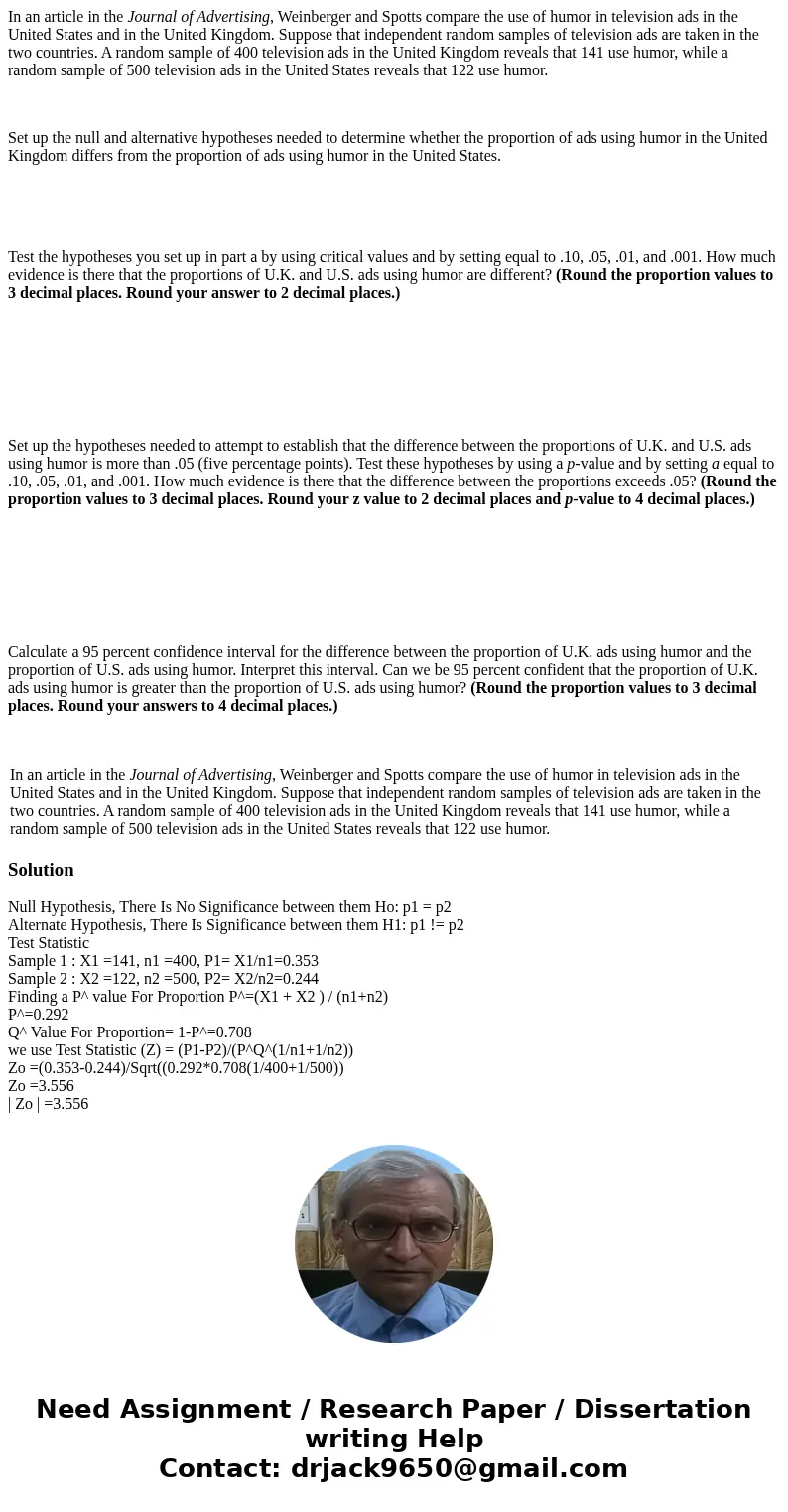In an article in the Journal of Advertising Weinberger and S
In an article in the Journal of Advertising, Weinberger and Spotts compare the use of humor in television ads in the United States and in the United Kingdom. Suppose that independent random samples of television ads are taken in the two countries. A random sample of 400 television ads in the United Kingdom reveals that 141 use humor, while a random sample of 500 television ads in the United States reveals that 122 use humor.
Set up the null and alternative hypotheses needed to determine whether the proportion of ads using humor in the United Kingdom differs from the proportion of ads using humor in the United States.
Test the hypotheses you set up in part a by using critical values and by setting equal to .10, .05, .01, and .001. How much evidence is there that the proportions of U.K. and U.S. ads using humor are different? (Round the proportion values to 3 decimal places. Round your answer to 2 decimal places.)
Set up the hypotheses needed to attempt to establish that the difference between the proportions of U.K. and U.S. ads using humor is more than .05 (five percentage points). Test these hypotheses by using a p-value and by setting a equal to .10, .05, .01, and .001. How much evidence is there that the difference between the proportions exceeds .05? (Round the proportion values to 3 decimal places. Round your z value to 2 decimal places and p-value to 4 decimal places.)
Calculate a 95 percent confidence interval for the difference between the proportion of U.K. ads using humor and the proportion of U.S. ads using humor. Interpret this interval. Can we be 95 percent confident that the proportion of U.K. ads using humor is greater than the proportion of U.S. ads using humor? (Round the proportion values to 3 decimal places. Round your answers to 4 decimal places.)
| In an article in the Journal of Advertising, Weinberger and Spotts compare the use of humor in television ads in the United States and in the United Kingdom. Suppose that independent random samples of television ads are taken in the two countries. A random sample of 400 television ads in the United Kingdom reveals that 141 use humor, while a random sample of 500 television ads in the United States reveals that 122 use humor. |
Solution
Null Hypothesis, There Is No Significance between them Ho: p1 = p2
Alternate Hypothesis, There Is Significance between them H1: p1 != p2
Test Statistic
Sample 1 : X1 =141, n1 =400, P1= X1/n1=0.353
Sample 2 : X2 =122, n2 =500, P2= X2/n2=0.244
Finding a P^ value For Proportion P^=(X1 + X2 ) / (n1+n2)
P^=0.292
Q^ Value For Proportion= 1-P^=0.708
we use Test Statistic (Z) = (P1-P2)/(P^Q^(1/n1+1/n2))
Zo =(0.353-0.244)/Sqrt((0.292*0.708(1/400+1/500))
Zo =3.556
| Zo | =3.556
Critical Value
The Value of |Z | at LOS 0.05% is 1.96
We got |Zo| =3.556 & | Z | =1.96
Make Decision
Hence Value of | Zo | > | Z | and Here we Reject Ho
P-Value: Two Tailed ( double the one tail ) -Ha : ( P != 3.5565 ) = 0.0004
Hence Value of P0.05 > 0.0004,Here we Reject Ho
We have evidence that proportion of ads using humor in the United Kingdom differs from the proportion of ads using humor in the United States
ANS:
Ho: p1 = p2 , H1: p1 != p2

 Homework Sourse
Homework Sourse